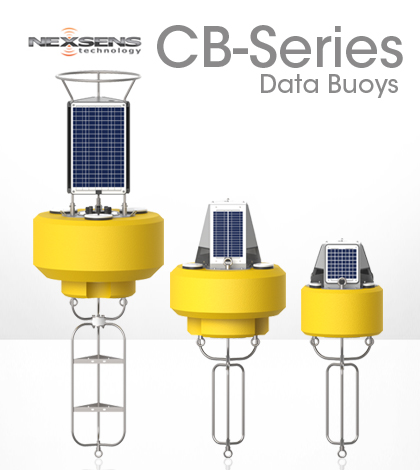NexSens CB-Series data buoys offers lineup from compact to powerful

NexSens CB-Series data buoys
The 2014 line of CB-Series data buoys combines traditional NexSens Technology reliability with a number of new innovations designed to handle real-time data collection applications in waters from the Great Lakes to the Arctic.
Each of the four CB-Series data buoys comes equipped with at least three solar panels, pass-through holes for water sensor deployment and topside mounts for weather sensors. But the buoys’ most exciting enhancement is the addition of a spacious, cross-compatible instrument well that protects your delicate electronics
“The biggest change is we now have a large data well that allows us to integrate batteries, data loggers and other electronics,” said Paul Nieberding, Fondriest Environmental general manager. “That gives the customer more freedom to integrate their equipment if desired.”
Weighing only 70 pounds, the CB-150 is NexSens’ most compact data buoy. The CB-150 fares best in smaller, calmer bodies of water, and excels in short-term deployments where heavy duty power supplies are unnecessary. Don’t be fooled by the buoy’s small profile, however: The CB-150 has proven its versatility through a recent deployment to the frigid waters of the Arctic Ocean.
The CB-450 is the next data buoy in the series, granting additional functionality with its larger size. The 10 inch diameter by 18 inch instrument well offers ample room for a variety of electronic devices. Three 4-inch pass-through holes provide make the buoy an excellent platform to deploy most multi-parameter water quality sondes. The size and power output of the CB-450 suit it to operations such as turbidity sensing, temperature profiling and meteorological monitoring on inland lakes.
Offering immense power and sensor payload, the CB-950 is ideal for deployment in the Great Lakes, coastal environments and projects requiring power-hungry peripherals. This hefty buoy features durable construction and a large instrument well, capable of holding multiple batteries and sensors. Three 30-watt solar panels keep the CB-950 running during long-term projects.
The largest data buoy of the series, the CB-1250 boasts the same innovations as the smaller models with the benefits of added internal space, a dual-tier solar array with six 30-watt panels, and buoyancy rated at 1,250 pounds.
“The buoys appeal to researchers that need to conduct in-situ measurements on open bodies of water, or regulatory projects during dredge operations where they need to monitor turbidity in real time,” Nieberding said.
Although the CB-Series is designed for professional research and monitoring applications, Nieberding said that water recreationists can benefit the buoys too. A CB-1250 recently deployed near Erie, Penn., transmits wave, turbidity and temperature data, as well as a live video feed to a website where it is available to swimmers and boaters.
CB-Series data buoys are compatible with many data loggers, but professionals in need of remote access to their data in extreme conditions should look no further than NexSens’ own iSIC data loggers.
“With a lot of the buoy platforms we integrate the iSIC data logger, along with a wireless telemetry model,” Nieberding said. “Options include radio to shore, cellular and iridium satellite. That allows customers to not only collect data but transmit it in real-time back to their office.”
Pricing for the CB-Series starts at $2,995 for the CB-150. Optional features include deep-cycle marine batteries, solar marine lights and sensor mounting hardware.




0 comments